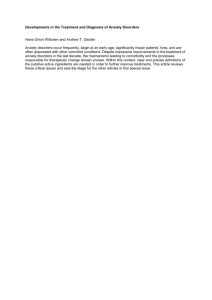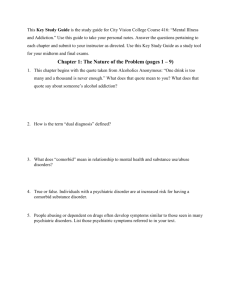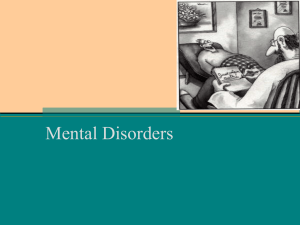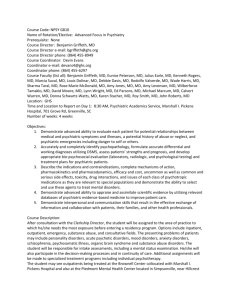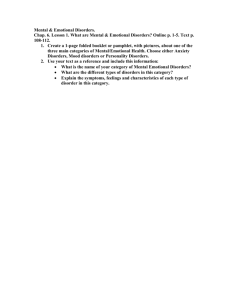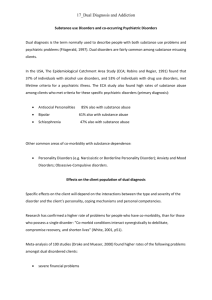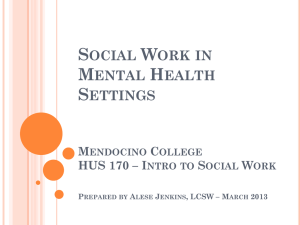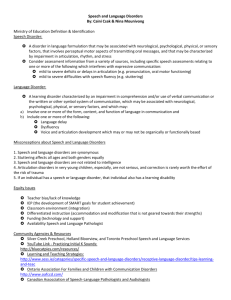Category: original research paper
advertisement
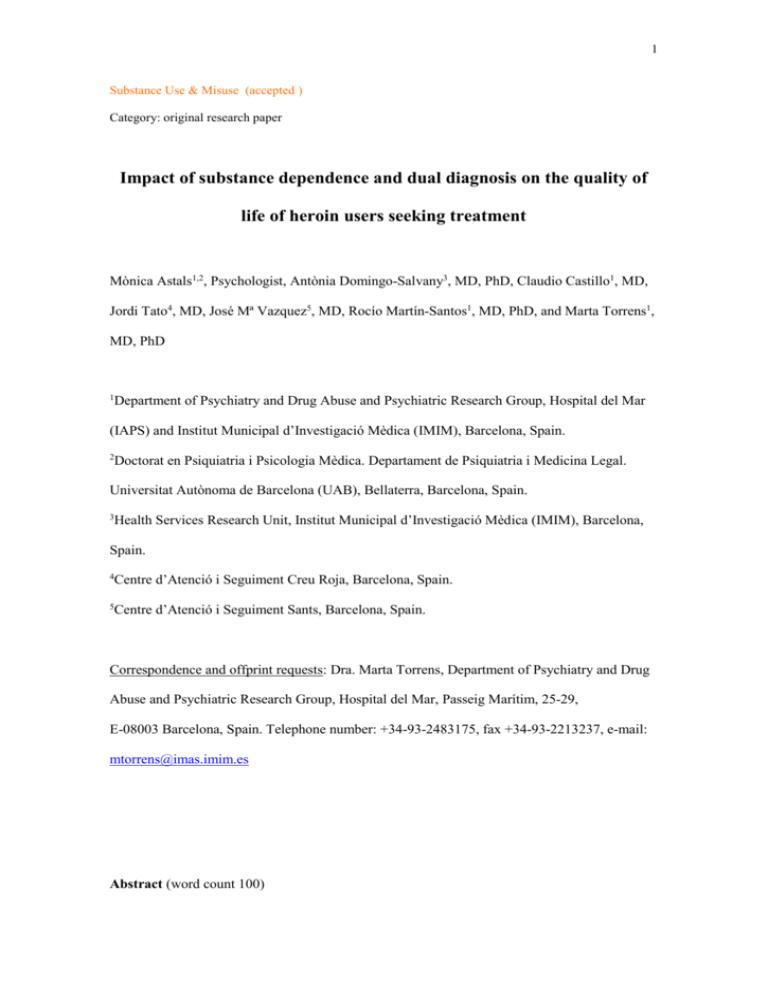
1 Substance Use & Misuse (accepted ) Category: original research paper Impact of substance dependence and dual diagnosis on the quality of life of heroin users seeking treatment Mònica Astals1,2, Psychologist, Antònia Domingo-Salvany3, MD, PhD, Claudio Castillo1, MD, Jordi Tato4, MD, José Mª Vazquez5, MD, Rocío Martín-Santos1, MD, PhD, and Marta Torrens1, MD, PhD 1 Department of Psychiatry and Drug Abuse and Psychiatric Research Group, Hospital del Mar (IAPS) and Institut Municipal d’Investigació Mèdica (IMIM), Barcelona, Spain. 2 Doctorat en Psiquiatria i Psicologia Mèdica. Departament de Psiquiatria i Medicina Legal. Universitat Autònoma de Barcelona (UAB), Bellaterra, Barcelona, Spain. Health Services Research Unit, Institut Municipal d’Investigació Mèdica (IMIM), Barcelona, 3 Spain. Centre d’Atenció i Seguiment Creu Roja, Barcelona, Spain. 4 Centre d’Atenció i Seguiment Sants, Barcelona, Spain. 5 Correspondence and offprint requests: Dra. Marta Torrens, Department of Psychiatry and Drug Abuse and Psychiatric Research Group, Hospital del Mar, Passeig Marítim, 25-29, E-08003 Barcelona, Spain. Telephone number: +34-93-2483175, fax +34-93-2213237, e-mail: mtorrens@imas.imim.es Abstract (word count 100) 2 In 189 opioid dependent subjects on methadone treatment in Barcelona (Spain), we assessed the prevalence of co-occurrence substance use and non-substance use disorders (dual diagnosis) by the Psychiatric Research Interview for Substance and Mental Disorders [PRISM], and the impact on quality of life (HRQoL) by the SF-12 (PCS-12 and MCS-12 scales). Rates of substance and non-substance use diagnoses were 59% and 32%, respectively. Mean scores for PCS-12 and MCS-12 were 44.1(sd 10.1) and 39.9 (sd 11.7), without differences by presence or absence of dual diagnosis. Heroin users on methadone treatment showed a high prevalence of dual diagnosis and a very impaired HRQoL. Keywords: Heroin dependence; dual diagnosis; psychiatic comorbidity; quality of life; methadone. Resumen (número de palabras 116) Se evaluó la prevalencia concomitante de trastornos por uso de sustancias (TUS) y trastornos no relacionados con el uso de sustancias (No-TUS) (diagnóstico dual) en 189 dependientes de opiáceos en tratamiento con metadona, mediante la entrevista PRISM, y su impacto en la calidad de vida mediante el SF-12 (componentes PCS-12 y MCS-12). La prevalencia actual de TUS y No-TUS fue del 59% y del 32%, respectivamente. Los valores medios del PCS-12 y el MCS-12 fueron 45.5 (ds 9.8) y 33.9 (ds 12.7). No se observaron diferencias entre los pacientes con o sin diagnóstico dual. Los dependientes de opiáceos en tratamiento con metadona mostraron una elevada prevalencia de diagnóstico dual y una peor calidad de vida. Palabras clave: dependencia de opiáceos; diagnóstico dual; comorbilidad psiquiátrica; calidad de vida; metadona Resumé (nombre de mots 130) 3 On étudie la prévalence de la cooccurrence de troubles par l’usage de substances et de troubles non liés aux substances (diagnostic duel) parmi 189 sujets avec dépendance des opiacés, avec l’ « Enquête de Recherche Psychiatrique pour troubles de substances et mentaux » (PRISM) et leur impact sur la Qualité de Vie Liée à la Santé (QVLS) avec la SF-12 (échelles physique (PCS-12) et mentale (MCS-12)). Le taux de diagnostics par substance et non-liés aux substances était de 59% et 32%, respectivement. Les valeurs moyennes pour la PCS-12 et MCS12 étaient 44.1 (s.d.: 10.1) et 39.9 (s.d.: 11.7), sans différences liées a la présence ou non de diagnostic duel. Les consommateurs d’héroïne en traitement avec de la méthadone avaient un taux élevé de diagnostic duel et une QVLS très détériorée. Mot-clé: la dépendance d’héroïne; diagnostic duel; comorbidity psychiatrique; qualité de la vie; méthadone. 4 Introduction Clinical and epidemiological studies have shown a high degree of co-occurrence of substance use disorders and non-substance use disorders (dual diagnosis). When compared with individuals with either disorder alone, dual patients show an increase in the use of emergency department services (Curran et al., 2003), high prevalence of suicide (Aharonovich et al., 2002) and increased rate of risk behaviors and related infections, such as HIV (King et al., 2000). In opioid dependent patients in different clinical and non-clinical samples, lifetime rates of nonsubstance use disorders reported a range between 44% and 86% (Bronner et al., 1997; ElandGoossensen et al., 1997; Chen et al., 1999; Krausz et al., 1999; King et al., 2000; Cacciola et al., 2001; Rodriguez-Llera et al., 2006), being major depression the most prevalent axis I disorder (4% to 44%) and antisocial personality disorder (25% to 39%) the most common axis II disorder. This wide range of rates might be due to: 1) temporal trends in the population related to either changes in illicit drug availability and price, drug culture preference, drug abuse treatment policies or presence of other concurrent diseases (i.e., HIV infection); 2) setting of assessment (clinical vs non-clinical samples); and 3) methodological issues, particularly the diagnostic criteria and the assessment instruments used. Variations in diagnostic criteria systems may produce different rates of non-substance use psychiatric disorders. While DSM-III-R and earlier nomenclatures were unclear in differentiating primary from other psychiatric disorders, DSM-IV provided clearer guidelines in diagnosing psychiatric disorders in heavy users of alcohol and drugs according to the following three categories: “primary” psychiatric disorders, “substance-induced” disorders, and “expected effects” of the substances, meaning expected intoxication and/or withdrawal symptoms that should not be diagnosed as symptoms of a psychiatric disorder. The World Health Organization (WHO) has defined quality of life as “individual's perception of their position in life in the context of the culture and value systems in which they live and in relation to their goals, expectations, standards and concerns. It is a broad ranging concept affected in a complex way by the person's physical health, psychological state, personal beliefs, social relationships and their relationship to salient features of their environment”. 5 Patient-perceived health-related quality of life (HRQoL) has become an important outcome in health care as an indicator of treatment effectiveness. HRQoL has been investigated in many populations, including general population and populations with specific diseases, especially chronic illnesses (Alonso et al., 2004). Studies indicate that chronic psychiatric patients report HRQoL scores as low or lower than those observed for several serious medical conditions (Spitzer et al., 1995). Moreover, studies in opioid-dependent subjects seeking treatment show that very poor HRQoL (Ryan et al., 1996; Torrens et al., 1997; Calsyn et al., 2004; Millson et al., 2004, Puigdollers et al., 2004) improves when subjects participate in substitution treatment (Torrens et al., 1997; 1999; Giacomuzzi et al., 2003; Puigdollers et al., 2003). There are a few studies on the influence of psychiatric disorders on HRQoL in heroin users. Fassino et al. (2004) found a more impaired quality of life in opioid dependent patients with personality disorders than in those without personality disorders or non-clinical controls. Recently, Bizzarri et al. (2005) studied 57 patients with opioid dependence alone and 41 with opioid dependence and a psychiatric axis-I disorder and found that dual diagnosis was associated with poorer quality of life. These authors emphasize the need to target treatment for mental disorder concomitantly with the dependence problem in patients in treatment for opioid dependence. The present study was conducted to explore the aspect of quality of life in opiate users and to further contribute to the knowledge of this important dimension in substance users. To have information available regarding the influence of concurrent disorders on the quality of life of heroin users will help to design more appropriate strategies for the integral care of these subjects and to strength the recommendation of measuring quality of life for future studies in this field. We hypothesized that HRQoL of heroin users admitted to methadone maintenance treatment (MMT) may be affected by co-occurrence of substance use and non-substance use psychiatric disorders. The main aims were to assess the prevalence of substance and nonsubstance use axis I disorders and two (antisocial and borderline) axis II disorders according to DSM-IV criteria, and to evaluate differences in HRQoL depending on the presence or absence of non-substance use psychiatric disorders. 6 Material and methods Patients The study participants were 189 opioid dependent patients (DSM-IV) admitted consecutively to three municipal outpatient low-threshold methadone maintenance programs (Puigdollers et al., 2003) in Barcelona, Spain. The sample size was calculated considering an estimated prevalence of non-substance use psychiatric disorders/dual diagnosis of 50% (Bronner et al., 1997), and allowing a maximum 95% confidence interval of 15% ( 7.5%). The study was carried out in three municipal outpatient treatment centers during the period between June 21st, 2000, to March 6th, 2002. First of all, at admission to MMT, they were fully informed by a nurse about the aims of the study. Moreover, they were told that to have information available regarding the influence of concurrent disorders on the quality of life of heroin users will help to design more appropriate strategies for the integral care of these subjects. Subjects who agreed gave written informed consent before inclusion in the study. Secondly, the same nurse used a close-ended questionnaire (as described below), designed ad hoc, in order to register the patient's background characteristics and the 12-item Short-Form (SF-12) to assess HRQoL. This took about 45 minutes. Finally, the same psychologist research interviewer with a master degree and clinical experience with patients with substance abuse or mental disorders assessed psychiatric diagnoses with the Psychiatric Research Interview for Substance and Mental Disorders (PRISM-IV) in all patients. The PRISM interview administration took about 2 hours depending on the clinical and toxicological characteristics of each patient. The study was approved by the institutional review board. Exclusion criteria were language-related barriers, severe cognitive impairment, or any medical disorder that would interfere with the research assessments. The 189 participants constituted 75.3% (189/251) of eligible new admissions to the treatment program during the study period. Thirty-five patients refused to take part in the study and 27 cases left treatment before completing initial assessment. No statistically significant age and gender differences were found between participants and non-participants. 7 Measures A close-ended questionnaire was used to register the patient's demographic characteristics (age, sex, family situation); employment status (currently employed, number of months employed); criminal status (criminal history; detention, number of detentions, imprisonment, number of imprisonments in the last 6 months); serological status (positive antibodies against HIV and hepatitis B and C virus); HIV risk behaviors (any i.v drug use, currently i.v. drug use -last 30 days-, age of first injection, any sharing injection material, currently sharing injection material, not always use of condom during last 6 months); substance use history (age of onset of regular use, days of use during the last 30 days, initial and current route of use and mean of amount use/day); and previous psychiatric treatment. Substance use and non-substance use psychiatric disorders were diagnosed according to DSM-IV criteria using the PRISM-IV (Torrens et al., 2004; Hasin et al., 2006). Although other interviews for psychiatric diagnoses based on DSM-IV criteria like SCID-IV (First et al., 1997), SCAN (Janca et al., 1994), CIDI (World Health Organization, 1998) were available, the PRISM-IV was selected because, as we are aware, there is the only one interview in which testretest reliability in substance abusers population has been provided (Hasin et al., 2006). Furthermore, in a validity study comparing diagnoses obtained through the PRISM-IV and SCID-IV in substance users using the Longitudinal Expert All Data (LEAD) procedure, for major depression, substance-induced psychosis, anxiety disorders, antisocial and borderline personality disorders, PRISM-LEAD agreement showed kappas substantially higher than SCIDLEAD agreement (Torrens et al., 2004). Quality of life was assessed at admission to MMT with the 12-item Short-Form (SF-12) questionnaire (Ware et al., 2002). The SF-12 is a reliable and valid generic quality of life instrument composed of 12 items derived from the SF-36 (Ware et al., 1994). The SF-36 was used to validate the ASI medical and psychiatric composite score (Casyn et al., 2004) and SF-12 has been used as a measure of HRQoL in the European Study of the epidemiology of mental disorders (ESEMed/MHEDEA 2000 investigators, 2004). In addition, the SF-12 was used in a 8 large U.S.A. national survey on drugs, alcohol and psychiatric cormobidity (Grant et al., 2004), to validate the diagnoses assessed in the survey. SF-12 responses are combined to generate both physical and mental component summary scales (PCS-12 and MCS-12, respectively) that are scored using norm-based methods. In our study, raw scores were weighted with the US coefficients that produced a mean of 50 and a standard deviation of 10 (therefore, scores above and below 50 are better and worse than average, respectively) in the American general population. To assess the degree of impairement in HRQoL of our patients we compared our data to SF-12 data obtained in the ESEMeD study with a general population sample (ESEMed/MHEDEA 2000 investigators, 2004). Statistical analysis Lifetime comorbidity data were used when analyzing sociodemographic features, substance use patterns, serological status, HIV risk behavior and previous treatments; and current comorbidity data were used when analyzing HRQoL. Categorical variables were compared using the chisquare test (2), when 20% or more of the cells had expected counts of less than five, the Fisher's exact test was used. The Student's t test and one-way analysis of variance were used to determine the relationship between a normally distributed quantitative variable and categorical variables with two or three levels, respectively. A logistic regression model was used to assess the independent contribution of non-substance use disorders/dual diagnosis of variables with p values <0.15 in the univariate analysis (Hosmer-Lemeshow statistics was used to assess the goodness of fit of the model). A multiple regression model was constructed to determine predictor variables associated with the physical and mental components of the SF-12 scale. Variables that in the univariate analysis had a p value <0.15 were assessed in the model and withdrawn in a backwards technique. Age and gender were forced into the model. Current nonsubstance use disorders, were also forced in the final model. To assess if HRQoL scores of the general population (the ESEMED database was accessible to us) and heroin dependent patients were statistically different we used the Welch test in those cases where variances were different and the Student's t test if they were not. 9 Results Of the 189 studied patients, 77% were male with a mean (SD) age of 33.8 (7.5) years (range 1856), 54% were single, most (73%) living with relatives, 40.2% had achieved only primary school, near 60% were currently employed, 66.7% had had at least one lifetime detention, and 90% had received previous treatment for opioid dependence. Almost 54% were infected with hepatitis C (HCV) and 24.3% were infected with HIV. Most (70.4%) had injected drugs intravenously at least once in their life, 33.3% shared injection materials, and 52.4% reported a sexual risk behaviour in the last 6 months (Table 1). At the time of admission to MMT, more than half (51.4%) were using heroin intravenously, whereas 27.4% were smoking it and 21.2% were snorting. The current route for cocaine use was mainly intravenous (57%) followed by snorting (22.8%) and smoking (20.2%) (Table 2). All patients had a DSM-IV lifetime heroin dependence diagnosis. About 61% also had a lifetime cocaine dependence diagnosis. Most of the subjects (71.4%; n = 135) showed more than one lifetime substance dependence diagnoses (mean [SD] 3.9 [1.8]). The most frequent current substance dependence diagnoses other than heroin were cocaine (35.8%) and sedatives (11.6%). Other substance use diagnoses are shown in Table 3. The overall rate for any lifetime substance use diagnosis other than heroin dependence was 88.9 %. About 34% of the sample was diagnosed with a lifetime non-substance axis I psychiatric disorder. Mood (18%) and anxiety (15.3%) disorders were the most common. Antisocial or borderline personality disorders were observed in 15.3% of the subjects. Overall, about 44% of the sample was diagnosed with either a lifetime axis I disorder or antisocial personality disorder or borderline personality disorder (detailled results are shown in Table 3). Current prevalence (last 12 months) of any axis I disorder was 20.6% being most prevalent anxiety (14.3%) and mood disorders (7.4%). Overall, 32.3% of the sample was diagnosed with either a current axis I disorder or antisocial or borderline personality disorder (Table 3). About 70% showed only one, 13.3% two, 12% three and 4.8% four or more non-substance use axis I 10 disorder or antisocial or borderline personality disorder diagnoses. Only 15.3% patients had received some lifetime psychopharmacological treatment for psychiatric disorder. Patients were classified into two groups based on the presence or not of lifetime nonsubstance use disorders (i.e., any axis I disorder and/or antisocial personality disorder and/or borderline personality disorder): 83 patients had a non-substance use psychiatric disorder/dual diagnosis (“comorbid” group), and 106 patients did not present a concomitant non-substance use psychiatric disorder (“non-comorbid” group). The comorbid group differed significantly from the noncomorbid in the percentage of women (61.4% vs 38.6%) and in the mean (SD) number of months employed in last 6 months (2.1 [2.4] vs 2.9 [2.7] months). Also, the comorbid group had longer history of lifetime psychiatric treatment (26.5% vs 6.6%). In relation to concurrent infectious diseases, comorbid patients showed more HCV infectious status (63.3% vs 46.5%,) than noncomorbid patient (table 1).. HRQoL data from the SF-12 were available for 175 patients. Mean (SD) values for the physical and mental component summary scales were 44.1 [10.1] and 36.9 [11.7], respectively. There were no significant differences between patients with and without current dual diagnosis in physical (43.8 [9.8] vs 44.3 [10.3]) and mental (36.7 [11.3] vs 37.1 [12.1]) scales. Furthermore, neither the physical nor the mental component summary scales were related to the number of dependence diagnoses and other psychiatric diagnoses. The physical component of the SF-12 was significantly related to marital status, education level, criminal record and initial route of heroine use (p < 0.05) (Table 4). In the multivariate analysis, educational level, criminal record, regular use of stimulants and cocaine during the last 30 days were associated with the physical component (Table 5). The mental component of the SF-12 was significantly related to starting route of cocaine use either in the univariate (Table 4) and the multivariate analysis when age, gender, and dual diagnosis were included (Table 5). Mean (SD) values for the physical and mental summary scales in the European general population were 52 (7.7) and 49.8 (9.3), respectively (28). These scales were both substantially and significantly higher in the general population than the means observed in this sample of 11 heroin-dependent patients (p < 0.001), indicating the severe impairment in the patient group even though subjects of the European survey were older (mean age 47 years) and included a lower proportion of men (48%). When comparing our results for individuals with specific psychiatric disorders, the mean scores especially for the mental scale, were very low for subjects with heroin dependence even when this was the only diagnosis. However, only comorbid “any anxiety disorder” contributed an additional significant decrement in the SF-12 mental scale compared to the general population (Table 6). Discussion This study shows that co-occurrence of substance use and non-substance use disorders is frequently diagnosed in opioid dependent subjects admitted to MMT. A total of 32% of heroin users had current and 44% had lifetime diagnoses of non-substance axis I or axis II (antisocial or borderline personality) disorders. Moreover, opioid dependent patients with only substance use disorder or with concomitant of substance use and non-substance use disorders showed a very poor HRQoL, specially in the mental domain of the SF-12 scale. To our knowledge this is the first study in which HRQoL was examined in opioid patients according to both axis I and II dual diagnosis. The use of a reliable and valid research instrument to assess comorbid DSM-IV disorders, the PRISM, also strengths the present results. According to these findings, assesment of non-substance use psychiatric disorders and measurement of HRQoL can be considered important elements for the integral care of opioid users seeking MMT. Some study limitations should be mentioned. One includes sample size; while this was calculated to achieve good precision in studying co-occurrence of non-substance use disorders, it may not have been sufficient to study differences in HRQoL by comorbidity, although a significant difference was found for comorbid anxiety disorders. Further, information was not available on the patients in whom assessments could not be completed, although our response rate (75%) was well within the acceptable level. Additionally, although antisocial and borderline personality disorders (the more frequent personality disorders described among substance abusers) were assessed, other personality disorders were not evaluated. This may 12 have led to an underestimation of overall personality disorder diagnoses in the study population. However, a USA national survey shows a very high level of association between personality disorders (Grant et al., 2005), so that it may be assumed that any underestimation may not have been relevant. Another limitation might be related to the generalizability of results. Although our sample represents about half of the total MMT new admissions in the city of Barcelona during the study period, subjects gender, age distribution, and proportion of injectors did not differ from the overall MMT admissions (Direcció General de Drogodependències i SIDA, 2002). Our HRQoL results using the SF-12 are consistent with studies using other instruments in showing that MMT patients have a very impaired HRQoL (Ryan et al., 1996; Torrens et al., 1997; Calsyn et al., 2004; Millson et al., 2004, Puigdollers et al., 2004) that is not further reduced by most types of concurrent non-substance use psychiatric disorders or the number of substance dependence diagnoses. Recently results from the European Study of the Epidemiology of Mental Disorders (ESEMed/MHEDEA 2000 investigators, 2004) showed that in the general population, both physical and mental mean scores were related to the number of disorders and also specific diagnoses. In our study, heroin dependent subjects presented a very impaired HRQoL, mainly affecting the mental domain (which was 14.3 points lower than the standard population mean, which was 50; thus 1.5 SD below the mean). As other current diagnoses did not significantly affect the mean impairment in our sample, heroin dependence itself appears to be the main reason for the low HRQoL, not leaving room for further impairment in ambulatory, non-institutionalized individuals. Although this fact could suggest an SF-12 "floor effect", its component summaries are not prone to such a problem and, in fact, lower mean values of the MCS with SF-36 have been reported in old depressed patients (Heiligenstein et al., 1995). Nevertheless, because patients refered poor HRQoL at entry to MMT, future studies assessing changes in HRQoL according to non-substance use disorders after being in methadone treatment during a period of time, would clarify the role of dual diagnosis in HRQoL of opioid dependent patients. These results agree with those found by Calsyn et al. (2004) using the SF-36 MCS: opioid addicts showed lower correlation between 13 ASI psychiatric composite score and SF-36 MCS than subjects with alcohol or cocaine abuse. We did not observe differences in HRQoL (neither SF-12 physical, nor mental scores) when considering physical comorbidity (i.e., HIV and HCV infection) whereas they observed a significant correlation between physical severity assesssed by ASI medical composite score and physical component scale of SF-36 on their sample of opioid addicts (Calsyn et al., 2004). The prevalence of non-substance use axis I disorders comorbidity found in this study is similar to other MMT samples (Stain et al., 1991; Brooner et al., 1997; King et al., 2000) and twice the prevalence found in the general population (ESEMed/MHEDEA 2000 investigators, 2004). Major depression, including primary (independent) and substance-induced was the most common lifetime non-substance use axis I disorder, whereas anxiety disorders were the most frequent current non-substance use psychiatric disorder diagnosed. The prevalence of both lifetime and current depression was similar to the 16% and 3% respectively, reported by Brooner et al. (1997), although in contrast with this study we found that major depression diagnoses were mainly primary and not substance-induced. Differences in diagnostic criteria (DSM-IV and DSM-III-R) and instruments used (PRISM and SCID) between the present study and the study of Brooner et al. (Brooner et al., 1997) may account for the differences observed. Our finding that primary major depression was more common than substance-induced major depression is consistent with comorbidity data from the National Epidemiologic Survey on Alcohol and Related Conditions (NESARC) (Grant et al., 2005), a general population study in which most of the mood disorders diagnosed in substance abusers were primary. The diagnosis of primary or substance-induced major depression in substance abusers is a relevant issue for adequate treatment. Differences in the diagnosis accuracy of samples included in clinical trials for major depression in substance abusers might explain the controversial results on antidepressant treatment efficacy reported. (Torrens et al., 2005) Furthermore, the increased risk of non-substance use disorders in women and an extra increase in risk for every additional substance use disorder, is consistent with results from previous studies in substance abusers (Hernandez-Avila et al., 2004; Kidorf et al., 2004; Rodriguez Llera et al., 2006). Otherwise, in contrast to previous studies that have shown that 14 psychiatric and substance use comorbidity are associated to higher rates of HIV risky behaviours (Strain et al., 1991), in our sample, neither differences in HIV status nor risk behaviours were found between comorbid and non-comorbid groups. HIV risk behaviours in opiate addicts have been related mostly to the presence of antisocial personality disorder (Brooner et al., 1993) and the low rates of antisocial personality disorder found in our study might justify the lack of differences. Health-related quality of life of heroin dependent patients seeking treatment has shown up once more as very impaired, specially its mental component, even in the absence of comorbid psychiatric disorders. With the development of additional designs such as longitudinal studies, more can be learned about the impact of co-occurrence of non-substance use disorders in health related quality of life. 15 Acknowlegments This study was supported by grants 00/810 and G03/005 from Fondo de Investigación Sanitaria (FIS), Madrid, Spain. We thank Marta Pulido, MD, for editing the manuscript and editorial assistance, Deborah Hasin, PhD, for useful comments and the nurses from treatment centres for their support to the study. 16 References Aharonovich, E., Liu, X., Nunes, E., Hasin, D.S. (2002). Suicide attempts in substance abusers: effects of major depression in relation to substance use disorders. American Journal of Psychiatry 159:1600-1602. Alonso, J., Ferrer, M., Gandek, B., Ware, J.E. J.r, Aaronson, N.K., Mosconi, P., Rasmussen, N.K., Bullinger, M., Fukuhara, S., Kaasa, S., Leplege, A. IQOLA Project Group. (2004). Health related quality of life associated with chronic conditions in eight countries: Results from the international quality of life assessment (IQOLA) project. Quality of Life Research 13:283-298. Bizzarri, J., Rucci, P., Vallotta, A., Girelli, M., Scandolari, A., Zerbetto, E., Sbrana, A., Iagher, C., Dellantonio, E. (2205). Dual diagnosis and quality of life in patients in treatment for opioid dependence. Subst Use Misuse 40:1765-1776. Brooner, R.K., Greenfield, L., Schmidt, C.W., Bigelow, G.E. (1993). Antisocial personality disorder and HIV infection among intravenous drug abusers. American Journal of Psychiatry 1993;150:53-58. Bronner, R.K., King, V.L., Kidorf, M., Schmidt, C.W., Bigelow, G. (1997). Psychiatric and substance use comorbidity among treatment-seeking opioid abusers. Archives of General Psychiatry 54:71-80. Cacciola J, Alterman A, Rutherford M, Mckay J, Mulvaney F. (2001). The relationship of psychiatric comorbidity to treatment outcomes in methadone maintained patients. Drug and Alcohol Dependence 61:271-280. Calsyn, D.A., Saxon, A.J., Bush, K.R., Howell, D.N., Baer, J.S., Sloan, K.L., Malte, C.A., Kivlahan, D.R. (2004). The Addiction Severity Index medical and psychiatric composite scores measure similar domains as the SF-36 in substance-dependent veterans: concurrent and discriminant validity. Drug and Alcohol Dependence 76:165-171. Chen, C.C., Tsai, S.Y., Su, L.W., Yang, T.W., Tsai, C.J., Hwu, H.G. (1999). Psychiatric comorbidity among male heroin addicts: differences between hospital and incarcerated subjects in Taiwan. Addiction 94:825-32. 17 Curran, G.M., Sullivan, G., Williams, K., Han, X., Collins, K., Keys, J., Kotrla, K.J. (2003). Emergency department use of persons with comorbid psychiatric and substance abuse disorders. Annals of Emergency Medicine 41:659-67. Direcció General de Drogodependències i SIDA. Generalitat de Catalunya. Departament de Sanitat i Seguretat Social. Sistema d’Informació sobre Drogodependències a Catalunya. Informe anual 2001. Barcelona. 2002. Eland-Goossensen M.A., Van der Goor L.A.M., Garretsen, H.F.L., Shudel, W.J. (1997). Opiate addicts in and outside treatment compared on psychopathology. European Addiction Research 3:164-172. ESEMeD/ MHEDEA 2000 investigators. (2204). Disability and quality of life impact of mental disorders in Europe: results from the European study of the epidemiology of mental disorders (ESEMeD) project. Acta Psychiatrica Scandinavica 109 (Suppl 420):38-46. Fassino, S., Daga, G.A., Delsedime, N., Rogna, L., Boggio, S. (2004). Quality of life and personality disorders in heroin abusers. Drug and Alcohol Dependence 76:73-80. First, M.B., Spitzer, R.L., Gibbon, M., Williams, J.B.W. (1997). Structured clinical interview for DSM-IV Axis I Disorders-Clinician Version (SCID-IV). American Psychiatric Press, Inc., Washington. 1997. Giacomuzzi, S.M., Riemer, M., Ertl, M., Rossler, H., Hinterhuber, H., Kurz, M. (2003). Buprenorphine versus methadone maintenance treatment in an ambulant setting: a healthrelated quality of life assessment. Addiction 98:693-702. Grant, B.F., Stinson, F.S., Dawson, D.A., Chou, S.P., Dufour, M.C., Compton, W., Pickering, R.P., Kaplan, K. (2004). Prevalence and co-occurrence of substance use disorders and independent mood and anxiety disorders. Archives of General Psychiatry 61:807-816. Grant, B.F., Stinson, F.S., Dawson, D.A., Chou, S.P., Ruan, W.J. (2005). Co-occurrence of DSM-IV personality disorders in the United States: results from the National Epidemiologic Survey on Alcohol and Related Conditions. Comprehensive Psychiatry 2005;46:1-5. Guyatt, G.H., Feeny, D.H., Patrick, D.L. (1993). Measuring health-related quality of life. A conceptual model of patients outcomes. Annals of Internal Medicine 118:622-629. 18 Hasin, D.S., Samet, S., Nunes, E., Meydan, J., Matseoane, K., Waxman, R. (2006) Diagnosis of comorbid disorders in substance users: Psychiatric Research Interview for Substance and Mental Disorders (PRISM-IV). American Journal of Psychiatry (in press). Heiligenstein, J.H., Ware, J.E. Jr., Beusterien, K.M., Roback, P.J., Andrejasich, C., Tollefson, G.D. (1995). Acute effects of fluoxetine versus placebo on functional health and well-being in late-life depression. Int Psychogeriatr 7:125-137. Hernandez-Avila, C.A., Rounsaville, B.J., Kranzler, H.R. (2004). Opioid-, cannabis- and alcohol-dependent women show more rapid progression to substance abuse treatment. Drug and Alcohol Dependence 74:265-272. Janca, A., Ustun, T.B., Sartorius, N. (1994). New versions of World Health Organization instruments for the assessment of mental disorders. Acta Psychiatrica Scandinavica 90:7383. Kidorf M, Disney ER, King VL, Neufeld K, Beilenson PL, Brooner RK. (2004). Prevalence of psychiatric and substance use disorders in opioid abusers in a community syringe exchange program. Drug and Alcohol Dependence 74:115-122. King, V.L., Kidorf, M.S., Stoller, K.B., Brooner, R.K. (2000). Influence of psychiatric comorbidity on HIV risk behaviors: changes during drug abuse treatment. Journal of Addictive Diseases 19:65-83. Krausz ,M., Verthein, U., Degkwitz, P. (1999). Psychiatric comorbidity in opiate addicts. European Addiction Research 5:55-62. Mason, B., Kocsis, J., Melia, D., Khuri, E.T., Sweeney, J., Wells, A., Borg, L., Millman, R.B., Kreek, M.J. (1998). Psychiatric comorbidity in methadone maintained patients. Journal of Addictive Diseases 17:75-89. Millson PE, Challacombe L, Villeneuve PJ, Fischer, B., Strike, C.J., Myers, T., Shore, R., Hopkins, S., Raftis, S., Pearson, M. (2004). Self-perceived health among Canadian opiate users: a comparison to the general population and to other chronic disease populations. Canadian Journal of Public Health 95 (Suppl 2, Health Module):99-103. 19 Puigdollers, E., Cots, F., Brugal, M.T., Torralba, L., Domingo-Salvany, A., Costas, F. (2003). Methadone maintenance programs with supplementary services: a cost-effectiveness study. Gaceta Sanitaria 17:123-130. Puigdollers E, Domingo-Salvany A, Brugal MT, Torrens, M., Alvaros, J., Castillo, C., Magri, N., Martin, S., Vazquez, J.M. (2004). Characteristics of heroin addicts entering methadone maintenance: quality of life and gender. Substance Use and Misuse 39:1353-1368. Rodriguez Llera, M.C., Domingo-Salvany, A., Brugal, M.T. (2005). Psychiatric comorbidity in young heroin users. Drug and Alcohol Dependence; in press. Ryan, C.F., White, J. (1996). Health status at entry to methadone maintenance treatment using the SF-36 health survey questionnaire. Addiction 91:39-45. Spitzer, R.L., Kroenke, K., Linzer, M., Hahn, S.R., Williams, J.B., deGruy, F.V., 3rd., Broody, D., Davies, M. (1995). Health-related quality of life in primary care patients with mental disorders. Results from the PRIME-MD 1000 Study. Journal of the American Medical Association 274:1511-1517. Strain, E.C., Brooner, R.K., Bigelow, G.E. (1991). Clustering of multiple substance use and psychiatric diagnoses in opiate addicts. Drug and Alcohol Dependence 27:127-134. Torrens, M., Domingo-Salvany, A., Alonso, J., Castillo, C., San, L. (1999). Methadone and quality of life. Lancet 353:1101. Torrens M, Fonseca F, Mateu G, Farré M. (2005). Efficacy of antidepressants in substance use disorders with and without comorbid depression. A systematic review and meta-analysis. Drug and Alcohol Dependence 78:1-22. Torrens, M., San, L., Martinez, A., Castillo, C., Domingo-Salvany, A., Alonso, J. (1997). Use of the Nottingham Health Profile for measuring health status of patients in methadone maintenance treatment. Addiction 92:707-716. Torrens, M., Serrano, D., Astals, M., Pérez-Domínguez, G., Martín-Santos, R. (2004). Diagnosing psychiatric comorbidity in substance abusers. Validity of the Spanish versions of Psychiatric Research Interview for Substance and Mental Disorders (PRISM-IV) and the 20 Structured Clinical Interview for DSM-IV (SCID-IV). American Journal of Psychiatry 161:1231-1237. Ware, J.E., Gandek, B. (1994). The SF-36 Health Survey: development and use in mental health research and the IQOLA Project. International Journal of Mental Health 23:49-73. Ware, J.E., Kosinski, M., Turner-Bowker, D.M., Gandek, B. (2002). How to score version 2 of the SF-12 Health Survey. Lincoln, RI, Quality Metrics. World Health Organization (WHO). (1998). Composite International Diagnostic Interview (CIDI). Core, Version 2.1. 21 Table 1. Sociodemographic and clinical characteristics of 189 opioid dependent patients with or without comorbidity admitted to a MMT Variable Male Female Age (mean + SD, years) Marital status Single Currently married Separated/divorced Living Relatives Alone Homeless Education level Primary school Secondary school High school or University Number months employeda (mean + SD) Any detention lifetime Overall sample N= 189, N (%) 145 (76.7) 44 (23.3) 33.85 + 7.47 Non-comorbid N= 106 N (%) 89 (61.4) 17 (38.6) 33.93 + 6.88 Comorbid N= 83 N (%) 56 (38.6) 27 (61.4) 33.73 + 8.21 102 (54) 57(30.1) 30 (15.9) 51(48.1) 35 (33) 20 (18.9) 138 (73) 38 (20.1) 13 (6.9) 2 or t df p 2=7.089 1 0.008 t= -0.181 187 0.856 51(61.4) 22 (26.5) 10 (12) 2=3.552 2 0.169 81 (76.4) 18 (17) 7 (6.6) 57 (68.7) 20 (24.1) 6 (7.2) 2=1.581 2 0.454 76 (40.2) 70 (37) 43 (22.8) 4.2 + 1.93 126 (66.7) 38 (35.8) 45 (42.5) 23 (21.7) 2.88 + 2.65 67 (63.2) 38 (45.8) 25 (30.1) 20 (24.1) 2.06 + 2.37 59 (71.1) 2=3.172 2 0.205 t= -2.235 2= 1.300 183 1 0.027 0.254 Serological status HIV- Ab positive (n= 185) HCV-Ab positive (n= 180) HBV- Ab positive (n= 175) HIV risk behaviours Any i.v. drug use Currently i.v. drug use b Age of 1st injection (mean,SD, years) Any sharing injection material Currently sharing injection material 45 (24.3) 97(53.9) 59 (33.7) 24 (23.1) 47 (46.5) 25 (25.3) 21 (25.9) 50 (63.3) 34 (44.7) 2=0.201 2= 5.009 2=7.304 1 1 1 0.654 0.025 0.007 133 (70.4) 95 (50.3) 22.46 + 6.16 63 (33.3) 6 (3.2) 69 (65.1) 54 (50.9) 23.13 + 5.82 31 (29) 3 (2.8) 64 (77.1) 41 (49.4) 21.73 + 6.46 32 (39) 3 (3.6) 2= 3.222 2=0.044 t= -1.310 2=2,111 2=0.093 1 1 131 1 1 0.073 0.833 0.192 0.146 1 Previous substance abuse treatments Detoxification Naltrexone Drug Free MMT No previous treatments 154 (81.5) 71 (37.8) 108 (57.4) 74 (39,2) 19 (10.1) 84 (79.2) 40 (38.1) 55 (52.4) 41 (38.7) 13 (12.3) 70 (84.3) 31 (37.3) 53 (63.9) 33 (39.8) 6 (7.2) 1 1 1 1 1 0.371 0.917 0.114 0.880 0.253 Previous psychiatric treatment 29 (15.3) 7 (6.6) 22 (26.5) 2=0.800 2=0.011 2=2.497 2=0.023 2=1.305 2=14.195 1 <0.001 22 Table 2. Substance use characteristics of 189 opioid dependent patients with or without comorbidity admitted in MM Drug use Overall N = 189 Noncomorbid N= 106 Comorbid N= 83 t df - 0.49 151 1 177 178 0.626 0.362 0.334 0.952 52 1 28 0.046 0.638 0.184 135 1 82 83 0.229 0.577 0.678 0.559 86 1 66 65 0.037 0.570 0.058 0.777 144 1 99 79 0.680 0.437 0.160 0.931 84 1 69 69 0.080 0.804 0.166 0.719 39 1 0.584 1 , P HEROIN Age of regular use (years + sd) Cases using last 30 days n, (%) Days of use last 30 days ( days + sd) Mean of amount use/day ( mg + sd) 23.0 + 6.4 179 (94.7) 25.8 + 7.7 641 + 507 23.3 + 5.7 99 (93.4) 25.3 + 8.3 640 + 493ª 22.8 + 7.3 80 (96.4) 26.4 + 6.9 636 + 526 a 26.8 + 7.9 18 (17.0) 18.1 + 8.9 22.6 + 7.1 12 (14.5) 13 + 11.6 23.7 + 6.4 84 (44.4) 13.8 + 12.4 691 + 611a 24.4 + 6.8 49 (46.2) 12.6 + 12.2 692 + 662ª 23.0 + 5.9 35 (42.2) 13.7 + 12.7 615 + 513ª 18.8 + 5.2 68 (36) 19.2 + 10.8 49 + 48b 19.8 + 5.9 40 (37.7) 20.2 + 10.6 45.9 + 40.9 b 17.4 + 3.8 28 (33.7) 0.323 15.0 + 11.5 49.2 + 54.1 b -2.124 16.6 + 3.6 101 (53.4) 19.9 + 11.6 2.3 + 2.6c 16.5 + 3.2 54 (50.9) 21.2 + 11.9 3.0 + 2.7 c 16.8 + 4.1 47 (56.6) 17.8 + 12 3.0 + 2.4 c 0.415 24.3 + 7.2 71 (37.6) 20.9 + 10.2 45.2 + 60d 25.6 + 6.7 39 (36.8) 17.7 + 10.3 43.9 + 40.1d 22.9 + 7.5 32 (38.6) 0.062 21.2 + 11.0 48.9 + 75.0 d -1.727 17.9 + 2.7 3 (1.6) 4.5 + 0.7 18.1 + 2.5 2 (1.9) 4.5 + 0.7 17.6 + 3.0 1 (1.2) 4.0 + (0) -0.553 0.830 0.969 - 0.060 OTHER OPIOIDS Age of regular use (years + sd) 24.6 + 7.7 30 (15.9) Cases using last 30 days n, (%) Days of use last 30 days ( days + sd) 16.8 + 10.4 -2.04 0.222 -1.364 COCAINE Age of regular use (years + sd) Cases using last 30 days n, (%) Days of use last 30 days ( days + sd) Mean of amount use/day ( mg + sd) -1.21 0.310 0.416 -0.587 ALCOHOL Age of regular use (years + sd) Cases using last 30 days n, (%) Days of use last 30 days ( days + sd) Mean of amount use/day ( mg + sd) -1.929 0.284 CANNABIS Age of regular use (years + sd) Cases using last 30 days n, (%) Days of use last 30 days (days + sd) Mean of amount use/day (mg + sd) 0.604 -1.417 0.087 SEDATIVES Age of regular use (years + sd) Use last 30 days n, (%) Days of use last 30 days (days + sd) Mean of amount use/day (mg + sd) 1.402 0.362 STIMULANTS Age of regular use (years + sd) Cases using last 30 days n, (%) Days of use last 30 days (days + sd) 0.139 NA 23 Table 3. Lifetime and current substance and non substance use disorders in 189 opioid dependent patients in MMT Lifetime N=189 (%) Current N=189 (%) 100 - 98.4 0.9 11.6 2.6 5.3 1.6 60.8 11.6 35.8 3.2 20.6 16.4 7.4 2.1 10.6 49.2 3.7 16.4 21.7 9 11.6 3.7 11.1 12.5 88.9 0.9 1.6 59.3 Non Substance Use Disorders Mood disorder Major depression Induced depression Psychotic disorders Schizophrenia Induced psychosis Anxiety disorders Panic with/without agoraphobia Social phobia Simple phobia Post traumatic stress Obsessive compulsive Eating disorders Anorexia Bulimia Any antisocial or borderline personality disorder Antisocial (APD) Borderline (BPD) Any axis I disorder 18 12.7 5.3 5.8 2.6 3.2 15.3 6.9 5.3 4.2 3.7 2.1 2.1 2.1 1.1 15.3 8.5 6.9 34.4 7.4 4.8 2.6 2.6 2.6 0 14.3 6.3 5.3 4.2 0 2.1 0.5 0 0.5 Any Axis I or APD or BPD 43.9 32.3 Substance Use Disorder Heroin Dependence Abuse Other Opioids Dependence Abuse Cocaine Dependence Abuse Alcohol Dependence Abuse Cannabis Dependence Abuse Sedative Dependence Abuse Stimulants Dependence Abuse Any SUD 20.6 24 Table 4. Mean values of SF-12 physical and mental component summary scales by sociodemographic, toxicological, medical and psychiatric variables in 175 opioid dependent patients in MMT Variable Gender Male (n=132) Female (n=43) Age (range) 18-29 (n=52) 30-36 (n=61) >37 (n=62) Marital Status Single (n=90) Currently married (n=56) Separated/divorcied (n=29) Education level Primary school (n=67) Secondary school (n=66) University (n=42) Any time in prison Yes (n=116) No (n=59) HIV risk behaviours Any i.v. drug use (n=123) Not i.v. drug use (n=52) Any sharing injection equip (n=57) Not sharing injection equip (n=118) HIV-Ab Positive (n=42) Negative (n=129) HCV-Ab Positive (n=88) Negative (n=78) Heroine, initial route Smoking (n=49) Snorting (n=97) Injecting (n=29) Other Opioids, regular use Yes (n=125) No (n=50) Cocaine Days of use last 30 days 0 (n=100) <30 (n=52) 30 (n=23) Initial route Smoking (n=27) Snorting (n=119) Injecting (n=21) Stimulants, regular use Yes (n=37) No (n=138) Primary psychotic disorder Yes (n=5) No (n=170) Current Psychiatry comorbidity Yes (n=61) No (n=114) PCS-12 Mean (s.d.) tof df p t = -1.874 1 0.065 44.7 (9.9) 43.6 (11.3) 43.9 (9.0) f =0.194 2 0.824 46.8 (9.0) 43.1 (9.9) 42.7 (10.5) f =3.051 2 43.1 (10.2) 46.6 (9.2) 41.7 (10.6) t =3.583 42.9 (10.4) 46.2 (9.2) MCS-12 Mean (s.d.) tof df p t = 364 1 0.717 38.5 (12.5) 35.8 (10.8) 36.6 (11.9) f =735 2 0.481 0.050 37.1 (11.4) 36.5 (12.3) 36.9 (11.8) f = 0.19 2 0.981 2 0.030 36.4 (11.3) 38.5 (11.9) 35.2 (11.9) f =1.087 2 0.339 t =-2.064 1 0.040 37.1 (11.8) 36.5 (11.5) t =0.318 1 0.751 43.2 (10.1) 46.1 (9.7) 43.9 (10.1) 44.1 (10.1) t =-1.747 1 0.082 t =-.623 1 0.534 t =-.104 1 0.917 36.5 (11.1) 37.7 (13.0) 35.0 (10.8) 37.8 (12.0) t =-1.516 1 0.131 43.3 (8.2) 44.3 (10.7) t =-.634 1 0.528 36.7 (10.6) 37.0 (12.1) t =-.162 1 0.871 43.0 (9.8) 45.0 (10.61) t =-1.247 1 0.214 35.3 (11.6) 38.6 (11.7) t =-1.831 1 0.069 f =3.258 2 0.041 f =2.536 2 0.082 t =0.443 1 0.658 t =-1.805 1 0.074 42.7 (10.5) 46.6 (9.2) 44.1 (9.0) f =2.624 2 0.075 37.3 (11.6) 36.0 (11.6) 37.2 (12.7) f =0.235 2 0.790 42.8 (8.5) 44.2 (10.4) 42.0 (9.2) f =0.581 2 0.560 34.6 (12.2) 38.5 (11.0) 32.4 (12.3) f =3.441 2 0.034 41.3 (9.5) 44.8 (s.d. 10.1) t =-1.880 1 0.062 36.2 (9.5) 37.1 (12.1) t =-.488 1 0.627 43.7 (10.1) 44.1 (s.d. 10.1) t =-.089 1 0.929 42.6 (11.1) 36.7 (11.7) t =1.105 1 0.271 43.4 (9.9) 44.4 (s.d. 10.2) t= -.617 1 0.538 37.1 (11.0) 36.8 (12.1) t= .177 1 0.860 43.3 (10.1) 46.5 (9.8) 43.0 (10.5) 45.6 (9.9) 40.6 (9.0) 43.5 (9.1) 44.3 (10.5) 37.1 (11.2) 36.3 (13.0) 37.7 (10.6) 37.8 (12.0) 32.5 (11.5) 34.6 (9.9) 37.8 (12.2) Table 5. Multiple regression models for Physical and Mental Component Summary scales (PCS-12 and MCS-12, respectively) in 175 opioid dependent patients in MMT Variable PCS-12 (s.e) 95% C.I. t P 25 Age Gender Male Female Education level Primary School Secondary School University Any time in prison Yes No Stimulants, regular use Yes No Cocaine, days of use last 30 days 0 <30 30 Current Dual Diagnosis Yes No Variable MCS-12 Age Gender Male Female Cocaine, initial route Smoking Snorting Injecting Current Psychiatric comorbidity Yes No -0.08 (0.10) -0.28 - 0.12 -0.81 0.42 -2.98 (1.72) 0 -6.4 - 0.42 - -1.73 - 0.08 1.45 (1.99) 4.62 (1.95) 0 -2.48 – 5.37 0.78 – 8.46 - 0.73 2.4 - 0.04 -3.61 (1.62) 0 -6.8 -0.43 - -2.24 - 0.03 -3.84 (1.84) 0 -7.45 –0.20 - -2.08 - 0.04 -1.53 (2.27) 2.74 (2.48) 0 -6.02 – 2.96 -2.15 – 7.62 - -0.67 1.11 - 0.04 -0.67 (1.61) 0 -3.86 – 2.51 - -0.42 - 0.68 -0.03 (0.12) -0.27 - 0.20 -0.28 0.78 0.08 (2.17) 0 -4.19 – 4.36 - 0.04 - 0.97 2.28 (3.46) 6.25 (2.73) 0 -4.55 – 9.12 0.85 – 11.64 - 0.66 2.29 - 0.04 0.02 (1.88) 0 -3.69 – 3.74 - 0.01 - 0.99 s.e= standard error; C.I= Confidence interval; t= student t test Table 6. Comparison of Physical and Mental Component Summary scales (PCS-12 and MCS-12, respectively) for particular disorders for the ESEMeD general population and heroin dependent patients PCS-12 MCS-12 EGP HDP n Mean C.I. No disorder 6,137 52.95 No current disorder 19,325 Any Mood disorder Mean C.I. 52.6 - 53.3 54.43 54.1 - 54.8 49.59 49.4 - 49.8 54.55 54.4 - 54.7 970 45.79 44.8 - 46.8 14 42.99 34.5 - 47.5 0.46* 40.36 Any Anxiety disorder 1,324 45.85 45.0 - 46.7 26 42.07 38.0 - 46.7 0.15* Alcohol dependence 51 49.79 47.3 - 52.3 13 42.59 36.5 - 48.7 0.58+ 15 42.95 79 44.35 Heroin dependence Heroin and dependence other n Mean EGP C.I. p HDP Mean C.I. 39.3 - 41.4 37.82 32.0 - 43.6 0.56* 45.86 45.0 - 46.7 36.57 32.3 - 40.8 0.01* 45.61 42.0 - 49.2 38.47 32.4 - 44.6 0.59+ 37.2 - 48.7 35.55 30.3 - 40.8 42.3 - 46.4 37.96 35.3 - 40.6 EGP, ESEMeD General Population (n=21.425); HDP, Heroin dependent patients (n=175) p 26 * Welch test; + Student t test.
